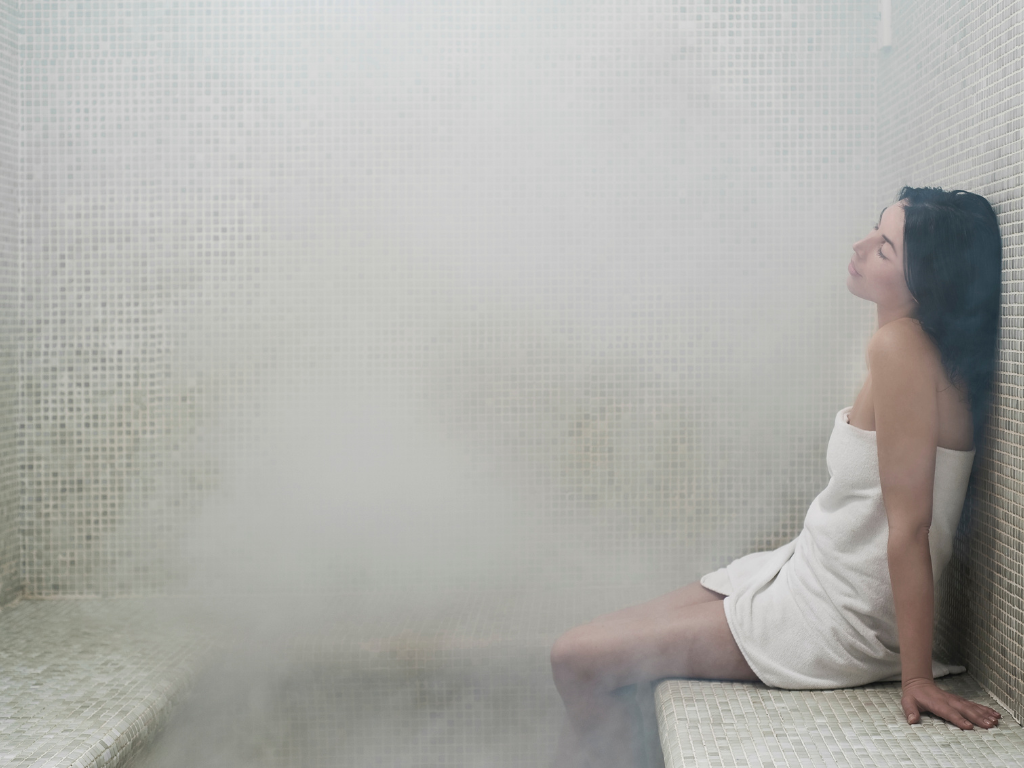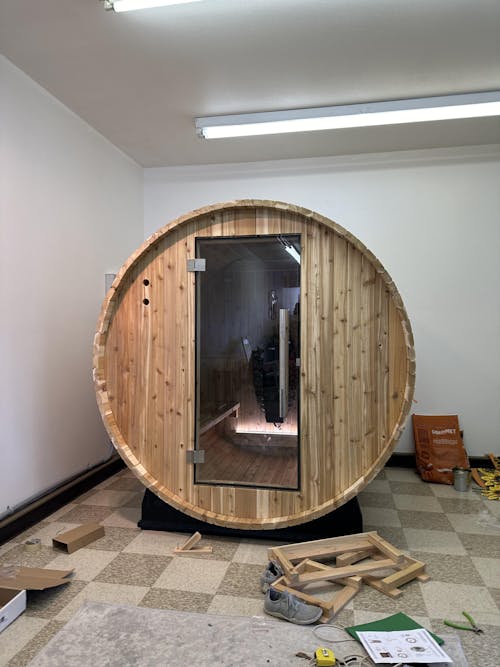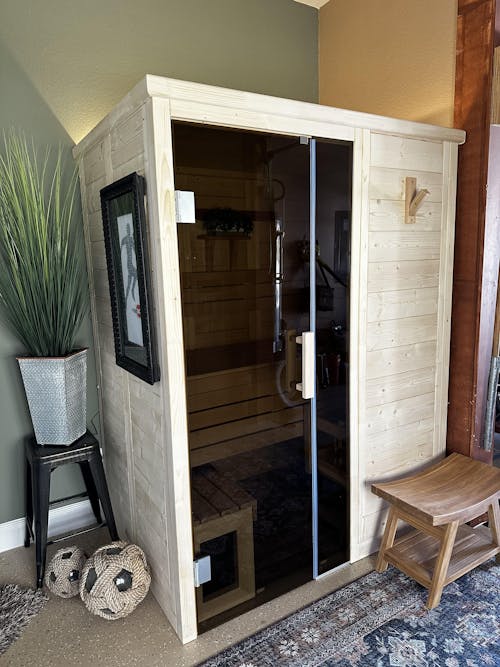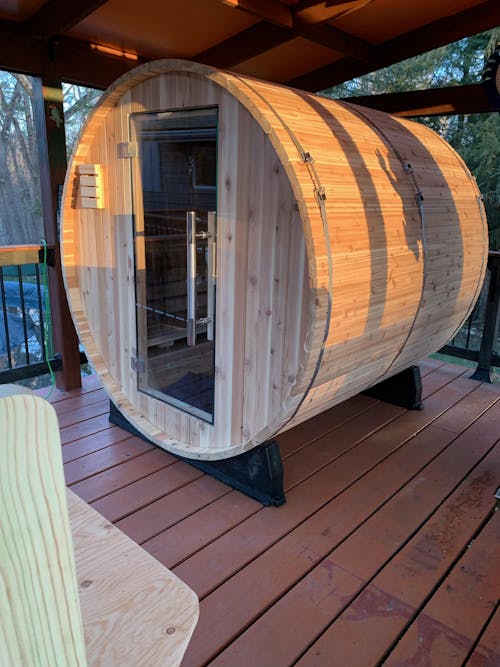SAUNA OR STEAM ROOM FOR COLD:
WHICH ONE IS BETTER?
When you're battling a cold, it feels like you're trapped in an endless cycle of discomfort and disruption. The sniffles, runny nose, and sore throat drag on for days, making it hard to concentrate and impossible to get any real work done.
If you're tired of taking over-the-counter medicine and looking for a healthy, all-natural antidote to the common cold, consider a trip to the sauna or steam room. These heat-based therapies may sound like simple relaxation luxuries, but they could be practical tools for fighting off colds and the flu.
Which one serves as a better option for cold relief: a sauna or steam room? In this article, we'll explore the working mechanism of these heated spaces, weigh the pros and cons, and help guide you toward the choice that best suits your needs.
Exploring the Effects of Cold on the Human Body
Before diving into the sauna and steam room debate, let's first look at how the common cold impacts our bodies.
The Centers for Disease Control and Prevention describes cold as a contagious respiratory illness that affects our nose, sinus, windpipe, and throat. There are more than 200 different viruses that can lead to cold-like symptoms. Among these, rhinoviruses are the most prevalent culprits, followed by parainfluenza viruses and certain seasonal coronaviruses.
The common cold spreads through direct contact with infected surfaces or through the air when someone with the virus coughs and sneezes around you. Contracting the virus affects the cells lining your nose and throat, ultimately using them as a host to multiply and propagate.
The pesky cold symptoms typically kick off with a sore throat, followed by nasal congestion, runny nose, coughing, and sneezing. You might also experience headaches, muscle aches, and a general sense of fatigue.
While most colds are relatively harmless and resolve independently within a week or two, they can affect your energy level and productivity. If you feel like dragging through your day, a sauna session or some time in a steam room might help you power through your cold.

Introducing Saunas and Steam Rooms
If you're thinking about visiting a sauna or steam room, you're in for a treat. Both of these heated spaces can induce sweating and relax the body, but the way they deliver that experience is very different. Here's what you need to know about saunas and steam rooms and how they can benefit you.
Traditional Saunas
Traditional saunas are the health-boosting havens that have been at the heart of Finnish culture for thousands of years. These saunas often boast a wooden stove or electric-powered heater that heats up a pile of rocks to a sizzling 150 to 200 degrees Fahrenheit.
When water is poured on the hot stones, it evaporates and increases the humidity in the room. The result? A dry heat with a smidge of humidity that stimulates a hearty sweat.
The dry heat of the sauna can work wonders for muscle relaxation, pain relief, improved circulation to reduce the chances of heart diseases, and promoting your body's natural detoxification process.
Steam Rooms
Also known as Turkish baths or hammams, steam rooms have a unique charm. Unlike saunas, steam rooms are enclosed spaces with a 100% humidity level. That means the air is hot and full of moisture.
A steam room's temperature is slightly lower than in a traditional sauna — approximately 110 to 120 degrees Fahrenheit. Don't let the lower degrees fool you, though! As a result of the high humidity, your body sweats profusely, making it feel just as hot.
The warm, moist air can have a fantastic effect on your skin and respiratory system. It relieves joint and arthritis pain, opens up your skin pores for a deep cleanse, and alleviates stress. It also relaxes your respiratory system, making it a go-to option for alleviating cold or allergy symptoms.
Sauna Benefits for Cold
Let's see how a sauna may help combat cold symptoms:
Strengthens Immune System
A robust immune system makes you well-equipped to fight off viruses and infections. As it turns out, sauna sessions can play a role in strengthening your immune system. Research shows that sauna use increases your core body temperature, mimicking a fever-like state. This phantom fever accelerates the production of white blood cells, leading to quicker recovery from the cold.
Increased Circulation and Oxygenation
The sauna might be your best friend if you're dealing with muscle pain or general fatigue. Studies show that sauna can help boost blood circulation and decrease hemoglobin binding capacity, meaning more oxygen and nutrients are being transported throughout your body, including those areas affected by a cold.
This can lead to decreased muscle pain and improved energy levels, contributing to overall well-being even when you're under the weather.
Improves Sleep Pattern
Runny noses and sore throats can keep you up all night. Sauna sessions may provide relief to those who spend hours tossing and turning. When you take a sauna session in the evening, it relaxes your muscles and soothes your throat. Post-sauna cool-off periods can also help signal the body that it's time to sleep.

Steam Room Benefits for Cold
Let's explore how a steam room can benefit you and provide much-needed relief.
Promotes Nasal Decongestion
Nasal sprays, while often seen as a staple for cold relief, can come with side effects that include irritation or even worsened congestion. Instead, why not treat your stuffy nose with the gentle, natural remedy a steam room offers?
MedicalNewsToday notes that warm, moist air helps to soften your nasal membranes, making it easier for them to drain and clear out any lingering mucus. This can also be beneficial for people suffering from congestion, sinusitis, or post-nasal drip.
Reduces Inflammation
The positive effects of a steam room are not limited to easing congestion. A key beneficial byproduct of using a steam room is reducing inflammation. NHS Fife explains that warm environments play a significant role in dilating blood vessels and decreasing cortisol levels — two factors that contribute to inflammation. Breathing in the moist air soothes the trachea and bronchial tissues, ultimately reducing sore throat.
Sauna or Steam Room: Which One Is Better for Cold?
When it comes to choosing between a sauna and a steam room for cold relief, it really depends on your symptoms. A sauna might be your best bet if you're dealing with a runny nose or finding it hard to relax due to a cold. The dry heat can help clear your nasal passages while enhancing your immune response.
On the other hand, if you're suffering from congestion or inflammation in your respiratory system, you might find a steam room to be more effective. The warm, moist air of a steam room can potentially help unclog respiratory passages and alleviate a sore throat. This will make it easy to eat your food or even take a deep, refreshing breath without the pain or discomfort that often comes with a cold.
It's important to note that occasionally, a cold can lead to more severe complications. For instance, a cold that lingers too long might morph into a sinus infection or even bronchitis. While saunas and steam rooms can offer some relief, it's essential to keep track of your symptoms and consult with your healthcare provider if you notice any worsening or persistent issues.

How to Use Sauna or Steam Room for Cold
The following are some handy tips to use a sauna or steam room to chase away the sniffles:
-
Select the time of the sauna session: It's best to take a sauna session as soon as you start noticing those familiar warnings, such as an annoying tickle in the throat or a runny nose. Early sauna sessions can help boost the immune response to fight off the cold virus. Choose a time when you're feeling relatively alert, as opposed to when fatigue dominates. This ensures you're in tune with how your body reacts during the session. Early morning sauna sessions can help start your day on a brighter note.
-
Adjust duration and frequency: You might think longer, more intense sessions might speed up your recovery. That's just a sauna health myth. If you can manage it, go for two to three shorter sessions of 10–15 minutes per day. This will help to keep those cold symptoms at bay.
-
Hydrate: When dealing with a cold or upper respiratory infection, your body needs even more fluids. Before hopping in a sauna, drink at least another glass more than you usually would. This will protect you from becoming dehydrated.
-
Clear nasal passage: A saline rinse can help soothe nasal passage, sinus cavities, and throat. Using it before your session will make breathing easier during your sauna time.
-
Opt for a gentle cool down: To avoid additional stress on your body, be sure to cool down gradually after your sauna session. Remember, you're already feeling a bit low, so treat your body kindly.
-
Replenish lost fluid: After having a shower, consider a warm bowl of soup. This will rehydrate you and provide valuable nutrients to help your body fight off invaders.
Possible Side Effects of a Sauna or Steam Room
Using a sauna or a steam room can have many health benefits, such as improving circulation, skin health, workout recovery, and reducing stress. However, there are also some possible side effects that you should be aware of before using them.
These include:
-
Heat discomfort or intolerance: Some people may find a sauna or steam room's high temperature and humidity uncomfortable or unbearable. This can cause symptoms such as dizziness, nausea, headache, or fatigue. If you experience any of these, you should immediately leave the sauna or steam room and cool down.
-
Low blood pressure: The heat of a sauna or a steam room can cause your blood vessels to dilate and your heart rate to increase, which can lower your blood pressure. This can be dangerous if you have a history of heart problems, fainting, or dehydration. You should monitor your blood pressure and heart rate before and after using a sauna or a steam room, and avoid staying in for too long.
-
Dehydration: Sweating in a sauna or a steam room can make you lose a lot of water and electrolytes from your body. This can lead to dehydration, affecting your kidney function, blood pressure, and cognitive performance. You should drink plenty of fluids before, during, and after using a sauna or a steam room, and avoid alcohol or caffeine, which can worsen dehydration.
-
Overheating: Staying in a sauna or a steam room for too long or at too high a temperature can cause your body to overheat, resulting in heat exhaustion or heat stroke. These are serious conditions that can damage your organs and even be fatal. You should limit your time in a sauna or a steam room to 15 to 20 minutes at most and gradually increase the temperature and duration as you get used to it. You should also take breaks to cool down and check your body temperature.

Sauna or Steam Room for Cold: FAQs
Are saunas good when you have a cold?
Saunas can be remarkably beneficial when you're dealing with a cold. Sauna heat can help relieve muscle pain, reduce inflammation and swelling, and boost your immune system.
Is it okay to use the sauna when sick?
It depends on your individual circumstances. Saunas can bolster the immune response, which is fantastic for preventing illness. However, when you're running a high fever or your symptoms are severe, saunas can strain your body unnecessarily. In that case, you should consult your healthcare provider before hopping into a sauna.
Should I use the steam room if I have the flu?
Absolutely! A steamy session can make a world of difference during flu season. The warm, moist heat helps thin out the mucus and wipe out germs and bacteria from your respiratory system. It also helps relieve congestion, one of the most common cold and flu symptoms.
Can a sauna treat chest infections?
While a sauna can temporarily relieve a chest infection, it's not a cure-all. The sauna's heat can decrease the severity of your symptoms by loosening up stubborn mucus or easing breathing discomfort. However, if you're suffering from a serious chest infection that continues to get worse, it's crucial to seek medical attention.
How often should I use a sauna when I have a cold?
When dealing with a cold, a daily sauna session can potentially help alleviate symptoms and speed up recovery. Since each person is unique, the frequency should be adjusted based on your comfort and how your body responds. Avoid overdoing it, as it may stress your body and make you feel worse.

Sauna or Steam Room for Cold: The Takeaway
That's the scoop on how a sauna and a steam room can be reliable allies when fighting the cold. Both these methods can help manage those cold symptoms while enhancing overall wellness.
Regardless of your wellness tool, getting a green light from your healthcare provider before turning up the heat is essential. This ensures the steamy treatment complements your body's healing needs without aggravating your existing symptoms.
If you're thinking about installing a home sauna or steam room, check out MySaunaWorld's collection of traditional and infrared saunas. For more information, contact us, and we'll be happy to guide you through the selection process.
SIGN UP. SAVE BIG.
Subscribe to be the first to know about our special monthly sauna sales, sent right to your inbox.

About the Author
Adam Fromson
Adam Fromson, co-founder of My Sauna World, loves saunas and their transformative health benefits. With years of experience exploring sauna culture and its impact on health and wellness, Adam is passionate about helping others discover the life-changing benefits of saunas for themselves.
Let customers speak for us
from 385 reviews
Good communication, easy delivery, easy set up, easy operation, great value. Recommended!

We ordered the 4 person barrel sauna and love it! We wanted a little extra space for the 2 of us/guests and it’s great. We could definitely fit 4 people in it if we needed. We use it every single day. It took about 10 weeks to get here because they build it specifically for the order. Putting the barrel together was fairly easy with 2 people. The electrical and the heater definitely required an electrician to install as we could have not done it alone.
We ordered the biggest heater (harvia spirit 8kw) and it heats up the sauna in about 15 mins inside our 40-50° garage. Overall this style of sauna is hotter and you sweat a lot faster than in an infrared sauna. I truly 10/10 recommend!
Pic is of us in the middle of building it.

Took me about 6 hours over 2 evenings to assemble almost all by myself. Had a pro run a new circuit from my panel. Very well made and assembly was straightforward. Heater is well sized and reaches operating temperature in under 30 minutes.

Great sauna very easy to assemble

The salt panel was a great addition to our Madison Sauna. It has excellent grain which is accented by the amazing color lights that glow through the panel. Also when you hit the rocks with a splash of water you can feel the heat bounce off the panel. Great addition if you are considering this option.

We can say enough about Sauna World there customer support is great! Our Pinnacle Sauna from Almost Heaven is epic.

The finish and quality is outstanding and it was quick and easy to assemble.

We are thrilled with our mini pod!! It came well shipped and our friend assembled it in 11 hours! Wow! We cannot wait to get healthy and sauna it up!

Beautiful sauna!!! Much easier than I expected to assemble, took a total of 4 hours. Can't wait to get warm by the pool on those cool evenings. Customer service was excellent..

Purchased a 2 person Almost Heaven barrel sauna and were delighted with the product. The order process was quick and easy, the sauna arrived on-time, installation was simple, following the provided instructions, and the sauna is extremely high quality. We’ve used it daily for over 2 weeks and quite frankly I don’t know how we lived without it. If I had it to do over again I wouldn’t change a thing... except maybe purchasing a 4 person model to easier share with friends!

Great Customer Service and a breeze to put together.Excellent shipping and the Sauna is top notch, couldn’t be happier






























